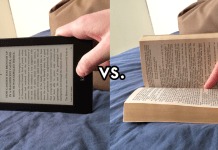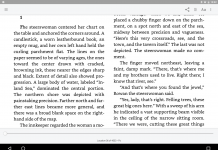 Author Tobias Buckell has spent a year experimenting with pricing for selling a short-story collection, Tides from the New Worlds, as an Amazon e-book. He has posted the results to his blog, complete with figures and charts.
Author Tobias Buckell has spent a year experimenting with pricing for selling a short-story collection, Tides from the New Worlds, as an Amazon e-book. He has posted the results to his blog, complete with figures and charts.
Buckell started out selling the book at $2.99. It sold a couple of dozen copies each for the first couple of months, and then sales tapered off. Then Buckell decided to raise the price to $4.99 and see what that did for his bottom line. It turned out that the number of people buying the book from month to month remained about the same, but since he was charging more he was making more money on it.
Subsequently, when Buckell tried dropping the price to 99 cents, he did get a boost in sales for about three days, but then they dropped back to the same level, even at the low 99 cent price.
Buckell wants to try the same experiment with a backlist novel, given that novels tend to sell better than story collections, and he also wants to try selling novellas/novelettes directly. He thinks that 99 cents would make a good introductory price to get people interested in an author’s other works, but prices in the $2.99-$4.99 range are more likely to earn the most money overall in the long run.
Obviously getting more titles into the pipeline will help, it would be steady money. And I’ve been encouraging authors to get their backlist up, with smart looking covers, for sale, so that they can benefit. 3-5 extra titles you own the rights to, making $50 each a month, is a car payment. Or more if any of the titles take off.
But at the moment, at least for him, continuing to publish “frontlist” titles traditionally still makes more financial sense. But what really makes sense to him is diversifying—continuing to work in print, e-books, and audiobooks.
While these figures only represent a relatively small sample—one book from one author—they are still good to have available, and can help writers make a more informed decision. It would be nice if more writers would post the same information.































Interesting blog post he has. He mentions the kindle several times, I wonder if he placed the book anywhere else? If you get 40 bucks a month at multiple vendors (BN, KOBO, SMASHWORDS etc) that seems like it would help both the bottom line and word of mouth. I’d love it now if he decided to up the ante on the experiment and actually do some mild advertising for it to see if it would pop sales.
Helen: that’s Kindle, B&N, and Apple, and direct via my website. Smashwords refused to let you upload an ePub and generally cheerfully mangles well put together and professionally designed eBooks and asks for 10% for the honor, so I refuse to use their ‘service’ until they allow direct ePub uploads (why they refuse when they’re selling epubs down the line is beyond me). Kobo and Sony stores just don’t sell that much to make it worth it to me. The big three percentages are in Kindle/BN/Apple and direct.
It’s interesting to watch people experiment. How cool is this time we live in?
I’m glad Tobias was willing to share his experiences, especially the part about increasing the price. As he stated in his post, authors have been reluctant to increase prices even to the 2.99 level.
My novel, Belvoir, was published in February. As of today, it has sold 22 copies at 0.99. Eventually, I will raise the price but not until I have other writings for sale. I’ve been posting my sales and publishing history at http://www.peelingcheek.wordpress.com.
S.A. Huggins
Author of Belvoir
I await with interest Howard’s explanation of why Buckell must be wrong, because according to him it’s impossible for the book to sell the same numbers at a higher price.
I do hope that nobody buys any more copies of this eBook from Amazon. It’s an exclusive eBook and because of that, This experiment is hurting people who do not read Amazon eBooks. He’s taking his work and telling people that they can go screw if they do not read Amazon eBooks.
JSWolf: didn’t you read his earlier comment that he also sells through B&N and Apple? that makes the book hardly exclusive.
B&N and Apple are still unusable to people who read with say a Sony Reader or a Pocketbook or any other device that doesn’t support B&N’s DRM or is not an iOS device that runs iBooks. So currently, they are useless to a lot of people. Why not sell someplace that gives people access world wide? The world is not just Apple, B&N, or Amazon. There is ePub with Adept DRM for the rest of us.
@JS: Tobias sells ePubs from his own site, so stop trying to bust his stones!
“There is ePub with Adept DRM for the rest of us.”
Or ePub with no DRM directly from the author for everyone…
http://www.tobiasbuckell.com/store/electronic-editions/tides-from-the-new-worlds-epub-edition/
I think what JS was saying is that for those with Sony, Kobo, etc they may not be aware of Mr Buckell’s new publication as there wouldn’t be a reason for them to go to Amazon or B&N. Why shop at places incompatible with your e-reader?
And unless you closely follow Mr Buckell’s career you wouldn’t go to his personal website to check what’s upcoming with any regularity.
It’s easy enough going to Amazon and B&N and still not being familiar with Tobias’ work; it can be that hard to find any individual artist, in or out of the big books sites, and those sites rarely offer alternative sales outlets.
This is a matter entirely different from the point of this post, and worthy of discussion elsewhere.
Outside of B&N/Amazon/Apple, the numbers for sales are so small it doesn’t make sense to deal with Kobo’s overly complicated submission system (last I checked it involved email and spreadsheets) or keeping the others going unless you’re showing serious traffic.
Should I spend hours to set things up on every single ebook retailer possible and make all of $10 here and there, or just host it via my site for anyone with the ability to use Google? It was an easy answer for me.